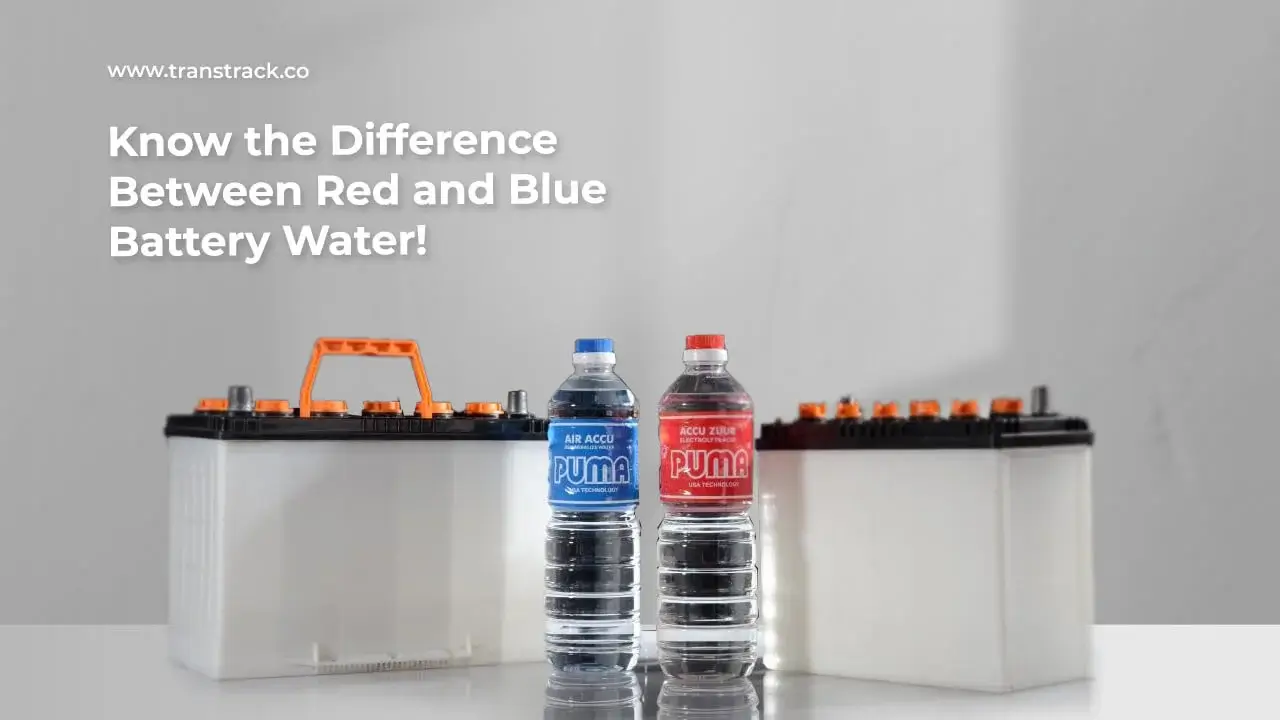Know the Difference Between Red and Blue Battery Water!

Battery water is an important element in maintaining the health of a vehicle battery. Apart from acting as a conductive medium for chemical processes in the battery, the balance of this element level can also affect the overall performance of the vehicle’s electrical system. In general, this element is divided into two types, namely red and blue. Both have different roles. So, what are the differences between red and blue?
In this article, TransTRACK will invite you to discuss the differences between the two commonly used types of battery water, namely red and blue. In addition, we will also discuss how to add water car battery that is appropriate and safe. Without further ado, let’s see the explanation below!
Types of Battery Water
Before getting into the differences between this element, it is important to understand that batteries require water as part of their internal chemical process. This element plays a very important role in maintaining the health and performance of a vehicle battery. Choosing the right type of this element can affect the electrical conductivity, battery life, and overall health of the vehicle’s electrical system. Therefore, the selection of the type of this element needs to be considered properly.
Generally, the water used to fill the battery consists of two types, namely red battery water and blue battery water. Here is the explanation:
Red Battery Water (Zuur Battery Water)
The Red or also known as zuur battery water is a type of element that has very strong acidic properties. This strong acidic nature comes from the sulfuric acid electrolyte liquid (H2SO4) which acts as a conductor and store of battery electrical power.
In general, this element has a slightly yellow color. However, some brands also issue a type of zuur battery water with a clear color. But you don’t need to worry about choosing the wrong one, because usually this element will be labeled with a red bottle cap, making it easier to recognize.
In the use of this element must be done carefully, because if exposed to the skin it will cause itching or irritation. In addition, this element can also cause corrosion if exposed to iron or metal.
Blue Battery Water (Distilled Water)
Meanwhile, the blue is a type of element that has gone through a distillation process to remove the mineral content in it. Because it goes through a distillation process, this element is also often referred to as distilled water.
Distillation of this element is very important, because the mineral content is corrosive and can damage the battery. This type of blue is safer, so it is not harmful if exposed to the skin.
As the name implies, this element often has a blue label on the packaging. So, the mention of this element is not based on the color of the water in it, but the color of the bottle cap or label on the packaging.
Difference between Red and Blue Battery Water
Now it’s time to discuss the differences between red and blue batteries. The difference between the two lies not only in color, but also in composition, usability, and others. Here is a complete explanation of the differences between this element:
Usage
The red one is used for the first time filling when the battery will be used which acts as a conductor and storage of electricity. Meanwhile, the blue one is used only to add electrolyte fluid if the amount is reduced. The blue one will only increase the volume of water without affecting the density of the electrolyte liquid.
Composition
Red and blue differ in their chemical composition. The red one often contains additives designed to increase electrical conductivity, while blue one tends to be purer and has less additives.
Properties
With more chemicals, the red one will be more corrosive than the blue. On the other hand, the blue tends to be cleaner, which reduces precipitation and corrosion. Thus, blue is safer than red.
How to Add Car Battery Water
Keeping this element level at the right limit is very important to ensure the battery functions properly. Here are some simple steps to top up your car’s battery water:
- Perform regular checks on the battery water level. Make sure that the water level is above the minimum limit.
- Use gloves to be safer
- Make sure to use the right battery water. Avoid using tap water which contains minerals and can damage the battery.
- Add water slowly until it reaches the maximum limit. Make sure not to exceed the limit, as it may cause problems in the battery charging process.
- Make sure there are no signs of leakage or damage to the battery cell.
- Done.
Battery maintenance not only has an impact on the performance of the battery itself, but also on the entire vehicle system. A healthy battery can ensure that the vehicle starts smoothly and the electrical system functions properly. In some cases, a poorly maintained battery can lead to more serious problems, such as the inability to start the vehicle or even damage to other components.
For more effective and efficient vehicle maintenance, including car batteries, you can utilize Vehicle Maintenance System (VMS) technology from TransTRACK. VMS makes it easy to monitor battery conditions in real-time, signal when battery problems occur, and implement overall vehicle preventive maintenance.
By understanding the difference between red and blue battery water, vehicle owners can make more informed decisions when maintaining their batteries. Awareness of the appropriate type of battery and water can help optimize vehicle performance in the long run. That’s all for now, see you in the next article!
Topic





